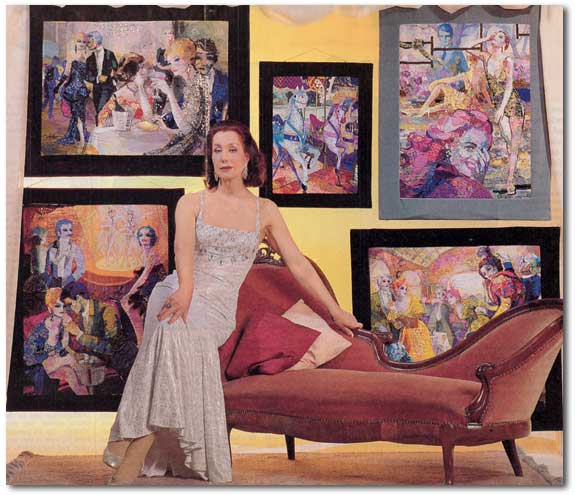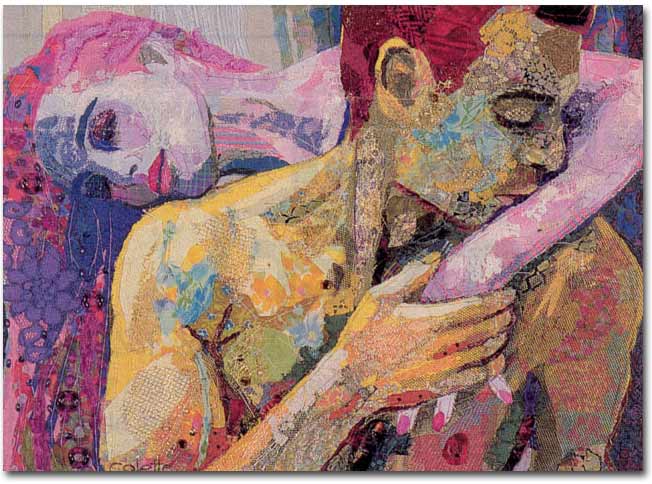- Colette
houdt ons voor het
lapje
- [Translator's note: There is no easy translation
for the Dutch expression "voor heet lapje houden".
Think of a magician and his magic handkerchief, or silk square.
Think of a young mother playing a Peek-a-boo with an infant (hiding
her face behind a cloth and then peering around the edge, delighting
a baby with the sudden appearance of a familiar face). In fact:
playing a little trick, to surprise, never to harm. In Colette's
case, there is the connection of working with actual bits of
fabric, and creating something unexpected, to delight. The general
usage in Dutch of the expression may apply to many situations,
not necessarily having anything to do with a piece of fabric.]
-
-
"Colette creates unexpected delights"
- The beautiful works of art Colette Berends produces are a
visual delight. Tenderness, elegance and romance seem to come
alive on beautiful paintings. Seem...because if you look really
close you will see that they consist totally of bits of fabric.
They are the creations of a woman who surprises us as well with
another aspect. The good looking Colette started her life as
a boy.
-
-

-
- Zwolle. Saturday.
-
- Only when you get up real close (put your nose close) to
the work of Colette Berends, do you see that they are not paintings,
but wall hangings (textile collages). Hundreds of pieces of fabric,
over each other, bits of lace, silk, velvet, satin, kept together
with some stitches, enhanced with small stones, beads, glitter.
"This effect can never be achieved with paint. Fabric is
much more expensive than paint, stronger, and with a glow. Of
course it is not so far removed from painting, you use the same
principles: you want to express something on a canvas. But instead
of paint, I try to achieve it with fabric. It is probably more
difficult than with paint. Fabric is concrete; you use that piece,
and that is it. With a brush you can change an image somewhat,
letting it fade, or changing the effect."
-
- Colette Berends (56) speaks in a low, somewhat cool voice.
One by one she hangs her wall hangings on the doorknob of a closet
in the hallway of her apartment in Zwolle. Her studio is too
small and too crowded to get a real look at the work. Besides,
the floor is covered with just received (from Frank Govers, a
Dutch fashion designer) small piles of fabric pieces (lapjes!!),
waiting to be sorted by color, made into small rolls, after which
they will be deposited in the appropriate bins stacked along
the wall.
-
- As subjects for the wall hangings serve nightclubs, romantic
theaters, ballet, the love between a man and a woman, mother
and child. "It it a little bit autobiographic as well. Although
you should not dig too deep in that respect. I have worked in
nightclubs, I love the theater, and love concerns us all. As
far as the Mother and Child subject is concerned: I was not able
to have children, but I can well imagine what it means to be
a mother.
-
-

-
- Colette's life has had many chapters. When she was twenty,
she decided that Zwolle was too confining and departed for the
wider world. First to Den Bosch, followed by The Hague, Brussels,
Geneve, and Hamburg where she worked as a window dresser (shop
window designer). [Translator's note: Etaleur, male designation
in Dutch. Etaleuse = female designation. Thus the story should
have said: HE worked as a window dresser. Because Colette is
transsexual and was born a boy].
-
- She decided in 1973 to undergo a sex change operation, after
which she would be officially a woman and could change her name.
("a part of my previous male name is incorporated in my
female name Colette"). It is impossible to now speak of
a "he", even when we speak of the past, about somebody
who now is so obviously a "she".
-
- "At some point I decided I wanted to do something else
than window dressing. I lived in Hamburg at the time. There were
nightclubs where men played female roles. These clubs were grand,
luxurious and very exclusive. There were about 10 of these artists
and I wished I was one of them. But, unfortunately, I had no
stage experience, and could not get the job. I went to Amsterdam
and started in a club there. After a year and a half I left for
the south of France, and worked in Athens, Zurich, Vienna. In
fact, all over Europe. I sang and danced. When I started this
chapter I was about thirty, an age when many give up this type
of career. I continued it till I was forty-eight." Colette
shows a picture from those years: she looks like Greta Garbo.
-
- During the day Colette dressed up as a woman and made up
her face. "Early on when I started work in the cabaret,
I still dresses as a young man during non-working hours. But
that was a bit odd as well. My nature was feminine. I liked being
beautiful, kept a slim figure, used a touch of makeup when going
out with my friend. A few hairs on my face had been removed.
My hair was a bit longer than the general style of boys, and
I had a delicate face. I was often addressed as "madam".
I was being somewhere between a male and female".
-
- At about thirty Colette started using hormones, having silicon
breast implants, and saving money for a sex change operation.
-
- "I have never regretted that. Right from the start it
was good, visually and functionally. Finally all was in harmony.
The way I felt, the way I looked. Free of all complexes. A lot
of people think of it primitively as just putting on a dress,
and that's it. But it involves becoming a woman, totally."
-
- When Colette thought herself too old to continue with cabaret
work she returned to Zwolle. There she started to make wall hangings.
"I wanted to do something that would make me happy for the
rest of my days. I had had a very exciting life and suddenly
I was stuck between four walls in an apartment. It was time to
do something or go nuts. I've always loved beautiful fabrics,
and wanted to create something with them."
-
- We are looking at "Mother and Child", in which
a young woman cradles a toddler. The boy frankly stares at you.
The expressions on the faces is so lifelike that it is almost
impossible to imagine that you can achieve the effect with bits
of fabric.
-
- "I spend a lot of time with the faces. Mouth or eyes
I cut directly with scissors. Then it is trying this way and
that way till they are proportioned right. The thread I use to
fasten it is used very deliberately. It functions like a brush
stroke, or pencil: wrinkles in a face, the contour of an eye.
A wall hanging as such takes hundreds of hours. It is important
that the composition is right, and a certain balance achieved.
Otherwise it becomes messy, just because there are so many colors."
-
- "Then I hang this picture on my wall for some time,
to see if the composition is indeed right". A gray cloth
is stretched over a hard board sheet and fastened with clothespins.
Basic forms are cut out from certain fabrics and fastened to
the gray cloth.
-
- This "canvas" is then place upright on her ironing
board against the wall of her studio. This enables her to have
a better view of the work in progress than when placed flat on
a table or floor. Then the real work starts: filling the "canvas"
with hundreds of pieces of fabric, usually several on top of
each other, till no trace of the original gray cloth is left.
A crate holding pieces of fabric of one particular color is dumped
on the floor where Colette spends hours finding just the right
piece. A first layer is pinned to the background, then a second,
a third, each layer contributing to a richer, many-hued total.
To give an idea: In "Mother and Child", a relatively
small "canvas" of 29 by 37 centimeters (11.5 by
14.5 inches), more than 300 pieces of fabric were used.
-
- "There are incredible quantities of color in my work.
And beautiful materials! Frank Govers and Rob Kroner (Dutch fashion
designers, haute couture) give me leftover pieces of their materials.
Often small pieces, but I do not need large quantities. Right
now I need a ribbon of gold lace. A very scarce resource. I first
need make a paper stencil and position it on the costly fabric,
to find the most advantageous layout before cutting. I frequently
visit flea markets and antique stores in my hunt for special
bits and pieces. There I find materials which are no longer available."
-
-
-
- Source: Telegraaf, 9 February 1991
By: Jolanda Jansen
- Translation from the Dutch: Puck Berends
- Return to Colette's story at:
-
- "Colette Berends: Her life and her art"
-



